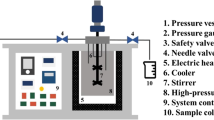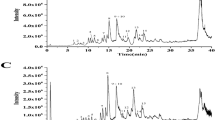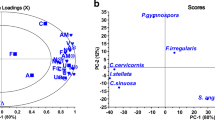Abstract
The interest in the extraction of polyphenolic compounds from plant materials is focused on upgrading of the large amount of by-products coming from food or cosmetics industries from which the press residues have particularly high contents of phenolics. In this study, for value-added use of the brown seaweed Ecklonia cava processing by-product (ECPB), which can be obtained after polyphenolic extraction of E. cava, it was fermented by the yeast Candida utilis and its antioxidant activities were evaluated by 1,1-diphenyl-2-picrylhydrazyl, hydroxyl, and alkyl radical scavenging using electron spin resonance spectrometer. ECPB was fermented for 1~4 days prior to being extracted with 80% ethanol, and significant differences were observed in extraction yields, total phenolic contents (TPC), and radical scavenging activities with the fermentation time. Extract from the ECPB fermented for 1 day exhibited the highest TPC and also found to be the strongest antioxidant. The 1-day fermented ECPB strongly enhanced cell viability against H2O2-induced oxidative damage in Vero cell line. This sample also exhibited good protective properties against H2O2-induced cell apoptosis as was demonstrated by a decreased quantity of sub-G1 hypodiploid cells and decreased apoptotic body formation in the flow cytometry analysis. This study demonstrated that the fermentation elevated functionally important polyphenolic contents of ECPB and resultant antioxidant activities were enhanced. Therefore, the fermentation could offer a tool to further increase the bioactive potential of ECPB.






Similar content being viewed by others
References
Ahn GN, Kim KN, Cha SH, Son CB, Lee J, Heo MS, Yeo IK, Lee NH, Jee YH, Kim JS, Heu MS, Jeon YJ (2007) Antioxidant activities of phlorotannins purified from Ecklonia cava on free radical scavenging using ESR and H2O2-mediated DNA damage. Eur Food Res Technol 226:71–79
Amarowicz R, Pegg RB, Rahimi-Moghaddam P, Barl B, Weil JA (2004) Free-radical scavenging capacity and antioxidant activity of selected plant species from the Canadian prairies. Food Chem 84:551–562
Athukorala Y, Jung WK, Vasanthan T, Jeon YJ (2006) An anticoagulative polysaccharide from an enzymatic hydrolysate of Ecklonia cava. Carbohydr Polym 66:184–191
Cai YJ, Ma LP, Hou LF, Zhou B, Yang L, Liu ZL (2002) Antioxidant effects of green tea polyphenols on free radical initiated peroxidation of liver microsomes. Chem Phys Lipids 120:109–117
Chandler SF, Dodds JH (1983) The effect of phosphate, nitrogen, and sucrose on the production of phenolics and solasidine in callus cultures of Solanum laciniatum. Plant Cell Rep 2:105–110
Chirinos R, Rogetz H, Campos D, Pedreschi R, Larondelle Y (2007) Optimization of extraction conditions of antioxidant phenolic compounds from mashua (Tropaeolum tuberosum Ruiz & Pavon) tubers. Separation Purification Technol 55:217–225
Choi CW, Kim SC, Hwang SS, Choi BK, Ahn HJ, Lee MY, Park SH, Kim SK (2002) Antioxidant activity and free radical scavenging capacity between Korean medicinal plants and flavonoids by assay-guided comparison. Plant Sci 163:1161–1168
Couto SR, Sanroman MA (2006) Application of solid-state fermentation to food industry—a review. Food Eng 76:291–302
Dimitrios B (2006) Sources of phenolic antioxidants. Trends Food Sci Technol 17:505–512
Dordevic TM, Siler-Marinkovic SS, Dimitrijevic-Brankovic SI (2010) Effect of fermentation on antioxidant properties of some cereals and pseudo cereals. Food Chem 119:957–963
Engelmann J, Volk J, Leyhausen G, Geurtsen W (2005) ROS formation and glutathione levels in human oral fibroblasts exposed to TEGDMA and camphorquinone. J Biomed Mater Res B Appl Biomater 75:272–276
Federica P, Benvenuti S, Magro L, Melegari M, Soragni F (2004) Analysis of phenolic compounds and radical scavenging activity of Echinacea spp. J Pharmaceut Biomed Anal 35:289–301
Geisen R, Farber P (2002) New aspects of fungal starter cultures for fermented foods. Appl Microbiol 2:13–29
Gschwind M, Huber G (1995) Apoptotic cell death induced by b-amyloid 1–42 peptide is cell type dependent. J NeuroChem 65:292–300
Heo SJ, Ko SC, Cha SH, Kang DH, Park HS, Choi YU, Kim D, Jung WK, Jeon YJ (2009) Effect of phlorotannins isolated from Ecklonia cava on melanogenesis and their protective effect against photo-oxidative stress induced by UV-B radiation. Toxicol in vitro 23:1123–1130
Hiramoto K, Johkoh H, Sako KI, Kikugawa K (1993) DNA breaking activity of the carbon-centered radical generated from 2,2′-azobis (2-amidinopropane) hydrochloride (AAPH). Free Radic Res Commun 19:323–332
Jacob JK, Hakimuddin F, Paliyath G, Fisher H (2008) Antioxidant and antiproliferative activity of polyphenols in novel high-polyphenol grape lines. Food Res Int 41:419–428
Kang KA, Lee KH, Park JW, Lee NH, Na HK, Surh YJ, You HJ, Chung MH, Hyun JW (2007) Triphlorethol-A induces heme oxygenase-1 via activation of ERK and NF-E2 related factor 2 transcription factor. FEBS Lett 581:2000–2008
Kim TH, Bae JS (2010) Ecklonia cava extracts inhibit liposaccharide induced inflammatory responces in human endothelial cells. Food Chem Toxicol 48:1682–1687
Kim KN, Heo SJ, Song CB, Lee J, Heo MS, Yeo IK, Kang KA, Hyun JW, Jeon YJ (2006) Protective effect of Ecklonia cava enzymatic extracts on hydrogen peroxide-induced cell damage. Process Biochem 41:2393–2401
Kim SK, Lee Y, Jung WK, Kim JH, Choi I, Park SG, Seo SK, Lee SW, Lee CM, Yea SS, Choi YH, Choi IW (2008) Effect of Ecklonia cava ethanolic extracts on airway hyperresponsiveness and inflammation in a murine asthma model: role of suppressor of cytokine signaling. Biomed Pharmacother 62:289–296
Kondo K, Saito T, Kajiwara S, Takagi M, Misawa N (1995) A transformation system for the yeast Candida utilis: use of a modified endogenous ribosomal protein gene as a drug-resistant marker and ribosomal DNA as an integration target for vector DNA. J Bact 177:7171–7177
Kong CS, Kim JA, Yoon NY, Kim SK (2009) Induction of apoptosis by phloroglucinol derivative from Ecklonia cava in MCF-t human breast cancer cells. Food Chem Toxicol 47:1653–1658
Kopani M, Celec P, Danisovic L, Michalka P, Biro C (2006) Oxidative stress and electron spin resonance. Clin Chim Acta 364:61–66
LeBel CP, Ischiropoulos H, Bondy SC (1992) Evaluation of the probe 2′, 7′-dichlorofluororescin as an indicator of reactive oxygen species formation and oxidative stress. Chem Res Toxicol 5:227–231
Lee JM, Chung H, Chang PS, Lee JH (2007) Development of a method predicting the oxidative stability of edible oils using 2, 2-dipenyl-1-picrylhydrazyl (DPPH). Food Chem 103:662–669
Lee SH, Han JS, Heo SJ, Hwang JY, Jeon YJ (2010) Protective effects of dieckol isolated from Ecklonia cava against high glucose-induced oxidative stress in human umbilical vein endothelial cells. Toxicol In Vitro 24:75–381
Li Y, Quian ZJ, Ryu B, Lee SH, Kim MM, Kim SK (2009) Chemical components and its antioxidant properties in vitro: an edible marine brown alga, Ecklonia cava. Bioorg Med Chem 17:1963–1973
Liyana-Pathirana CM, Shahidi F (2007) Antioxidant and free radical scavenging activities of whole wheat and milling fractions. Food Chem 101:1151–1157
Lizard G, Fournel S, Genestier L, Dhedin N, Chaput C, Flacher M, Mutin M, Panaye G, Revillard JP (1995) Kinetics of plasma membrane and mitochondrial alterations in the cells undergoing apoptosis. Cytometry 21:275–283
Loetchutinat C, Kothan S, Dechsupa S, Meesungnoen J, Jay-Gerrin JP, Mankhetkorn S (2005) Spectrofluorometric determination of intracellular levels of reactive oxygen species in drug-sensitive and drug-resistant cancer cells using the 2′, 7′-dichlorofluororescein diacetate assay. Radiat Phys Chem Oxf 72:323–331
Lotito SB, Frei B (2004) Relevance of apple polyphenols as antioxidants in human plasma: contrasting in vitro and vivo effects. Free Radic Biol Med 36:201–211
Martha JF, Miranda L, Doblado R, Vidal-Valverde C (2005) Effect of germination and fermentation on the antioxidant vitamin content and antioxidant capacity of Lupinus albus L. var. Multolupa. Food Chem 92:211–220
Miura Y, Kondo K, Saito T, Shimada H, Fraser PD, Misawa N (1998) Production of the carotenoids lycopene, β-carotene, and astaxanthin in the food yeast Candida utilis. Appl Environ Microbiol 64:1226–1229
Mosmann T (1983) Rapid colorimetric assay for cellular growth and survival: application to proliferation and cytotoxicity assays. J Immunol Meth 65:55–63
Nanjo F, Goto K, Seto R, Suzuki M, Sakai M, Hara Y (1996) Scavenging effects of tea catechins and their derivatives on 1, 1-diphenyl-2-picrylhydrazyl radical. Free Radic Biol Med 21:895–902
Nicoletti I, Migliorati G, Pagliacci MC, Grignani F, Riccardi C (1991) A rapid and simple method for measuring thymocyte apoptosis by propidium iodide staining and flow cytometry. Immunol Methods 139:271–9
Peschel W, Rabaneda FS, Diekmann W, Plescher A, Gartzia I, Jimenez D, Raventos RL, Buxaderas S, Codina C (2006) An industrial approach in the search of natural antioxidants from vegetable and fruit wastes. Food Chem 97:137–150
Rosen GM, Rauckman EJ (1980) Spin trapping of the primary radical involved in the activation of the carcinogen N-hydroxyl-2- acetylaminoflurene by cumene hydroperoxide hematin. Mol Pharmacol 17:233–238
Seifried HE, Anderson DE, Fisher EI, Milner JA (2007) A review of the interaction among dietary antioxidants and reactive oxygen species. J Nutr Biochem 18:567–579
Shahidi F, Liyana-Pathirana CM, Wall DS (2006) Antioxidant activity of white and black sesame seeds and their hull fractions. Food Chem 99:478–483
Shibata T, Ishimaru K, Kawaguchi S, Yoshikawa H, Hama Y (2008) Antioxidant activities of phlorotannins isolated from Japanese Laminariacea. J Appl Phycol 20:705–711
Shim SY, To LQ, Lee SH, Kim SK (2009) Ecklonia cava extract suppresses the high-affinity IgE receptor, FcRIε expression. Food Chem Toxicol 47:555–560
Temple NJ (2000) Antioxidants and disease: more questions than answers. Nutr Res 20:449–459
Wang BG, Zhang WW, Duan XJ, Li XM (2009) In vitro antioxidative activities of extract and semi-purified fractions of the marine red alga, Rhodomela confervoides (Rhodomelaceae). Food Chem 113:1101–1105
Young FM, Phungtamdet W, Sanderson BJS (2005) Modification of MTT assay conditions to examine the cytotoxic effects of amitraz on the human lymphoblastoid cell line, WIL2NS. Toxicol In Vitro 19:1051–1059
Zubia M, Robledo D, Pelegrin YF (2007) Antioxidant activity in tropical marine macroalgae from the Yucatan Peninsula, Mexico. J Appl Phycol 19:449–458
Author information
Authors and Affiliations
Corresponding author
Rights and permissions
About this article
Cite this article
Wijesinghe, W.A.J.P., Won-Woo, L., Young-Mog, K. et al. Value-added fermentation of Ecklonia cava processing by-product and its antioxidant effect. J Appl Phycol 24, 201–209 (2012). https://doi.org/10.1007/s10811-011-9668-1
Received:
Revised:
Accepted:
Published:
Issue Date:
DOI: https://doi.org/10.1007/s10811-011-9668-1




